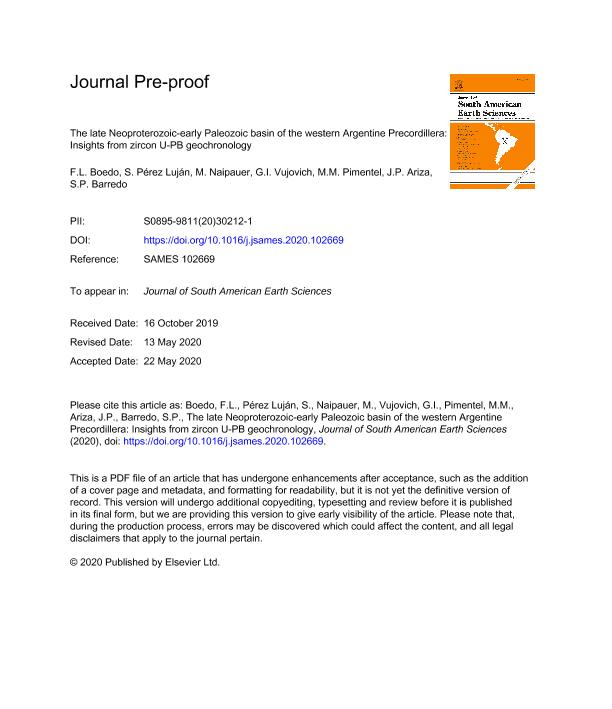Mostrar el registro sencillo del ítem
dc.contributor.author
Boedo, Florencia Lucila

dc.contributor.author
Perez Lujan, Sofia Beatriz

dc.contributor.author
Naipauer, Maximiliano

dc.contributor.author
Vujovich, Graciela Irene

dc.contributor.author
Martins Pimentel, Márcio

dc.contributor.author
Ariza, Juan Pablo

dc.contributor.author
Barredo, Silvia Patricia
dc.date.available
2022-03-23T20:04:03Z
dc.date.issued
2020-10
dc.identifier.citation
Boedo, Florencia Lucila; Perez Lujan, Sofia Beatriz; Naipauer, Maximiliano; Vujovich, Graciela Irene; Martins Pimentel, Márcio; et al.; The Late Neoproterozoic-Early Paleozoic basin of the western Argentine Precordillera: Insights from zircon U-Pb geochronology; Pergamon-Elsevier Science Ltd; Journal of South American Earth Sciences; 102; 102669; 10-2020; 1-17
dc.identifier.issn
0895-9811
dc.identifier.uri
http://hdl.handle.net/11336/153855
dc.description.abstract
In central-western Argentina, a belt including marine metasedimentary rocks and mafic-ultramafic bodies occurs throughout the western margin of the Precordillera. The belt is considered as the suture zone between the poorly known Chilenia terrane and the Cuyania terrane, part of the composite West Gondwana margin. It is assigned to the Late Neoproterozoic-Early Devonian based on fossil fauna and radiometric ages. In the southern sector of this belt, in the Peñasco area, two units crop out. The Peñasco Formation comprises metasandstone and metapelite spatially associated with mafic metavolcanic and metahyaloclastic rocks. Metagabbro bodies intrude the succession. The Garganta del León Formation consists of metasandstone and scarce metapelite where tractive and deformational sedimentary structures are preserved. Both units are affected by low-grade metamorphism, but the main foliation S1 and crenulation cleavage S2 are better developed in the Peñasco Formation rocks. U-Pb data on detrital zircon of two metasandstone samples from these units show a dominant detrital input from sources with 1.0–1.3 and 0.65–0.53 Ga ages. Detritus may come from reworked sedimentary units or from igneous/metamorphic complexes from the Cuyania terrane basement that was possibly exhumed in the Ocloyic orogen. A Gondwanan provenance for the Late Neoproterozoic-Cambrian population would also be plausible. A ca. 460 Ma zircon population in the Garganta del León Formation is interpreted to be derived from the Famatinian Arc. This would imply that the deposition of the sediment occurred after the collision of the Cuyania terrane against West Gondwana, and that the Ocloyic orogen acted as a barrier for detritus from the Famatinian Arc and other rocks further east.
dc.format
application/pdf
dc.language.iso
eng
dc.publisher
Pergamon-Elsevier Science Ltd

dc.rights
info:eu-repo/semantics/openAccess
dc.rights.uri
https://creativecommons.org/licenses/by-nc-sa/2.5/ar/
dc.subject
CHILENIA TERRANE
dc.subject
CUYANIA TERRANE
dc.subject
DETRITAL ZIRCON
dc.subject
MAFIC-ULTRAMAFIC BELT
dc.subject
SEDIMENTARY PROVENANCE
dc.subject.classification
Geología

dc.subject.classification
Ciencias de la Tierra y relacionadas con el Medio Ambiente

dc.subject.classification
CIENCIAS NATURALES Y EXACTAS

dc.title
The Late Neoproterozoic-Early Paleozoic basin of the western Argentine Precordillera: Insights from zircon U-Pb geochronology
dc.type
info:eu-repo/semantics/article
dc.type
info:ar-repo/semantics/artículo
dc.type
info:eu-repo/semantics/publishedVersion
dc.date.updated
2022-03-14T21:15:41Z
dc.identifier.eissn
1873-0647
dc.journal.volume
102
dc.journal.number
102669
dc.journal.pagination
1-17
dc.journal.pais
Países Bajos

dc.journal.ciudad
Amsterdam
dc.description.fil
Fil: Boedo, Florencia Lucila. Consejo Nacional de Investigaciones Científicas y Técnicas. Oficina de Coordinación Administrativa Ciudad Universitaria. Instituto de Estudios Andinos "Don Pablo Groeber". Universidad de Buenos Aires. Facultad de Ciencias Exactas y Naturales. Instituto de Estudios Andinos "Don Pablo Groeber"; Argentina
dc.description.fil
Fil: Perez Lujan, Sofia Beatriz. Consejo Nacional de Investigaciones Científicas y Técnicas. Centro Científico Tecnológico Conicet - San Juan. Centro de Investigaciones de la Geosfera y Biosfera. Universidad Nacional de San Juan. Facultad de Ciencias Exactas Físicas y Naturales. Centro de Investigaciones de la Geosfera y Biosfera; Argentina
dc.description.fil
Fil: Naipauer, Maximiliano. Consejo Nacional de Investigaciones Científicas y Técnicas. Oficina de Coordinación Administrativa Ciudad Universitaria. Instituto de Geocronología y Geología Isotópica. Universidad de Buenos Aires. Facultad de Ciencias Exactas y Naturales. Instituto de Geocronología y Geología Isotópica; Argentina
dc.description.fil
Fil: Vujovich, Graciela Irene. Secretaría de Industria y Minería. Servicio Geológico Minero Argentino; Argentina. Consejo Nacional de Investigaciones Científicas y Técnicas. Oficina de Coordinación Administrativa Ciudad Universitaria. Instituto de Estudios Andinos "Don Pablo Groeber". Universidad de Buenos Aires. Facultad de Ciencias Exactas y Naturales. Instituto de Estudios Andinos "Don Pablo Groeber"; Argentina
dc.description.fil
Fil: Martins Pimentel, Márcio. Universidade do Brasília; Brasil
dc.description.fil
Fil: Ariza, Juan Pablo. Universidad Nacional de San Juan. Facultad de Ciencias Exactas, Físicas y Naturales. Instituto Geofísico Sismológico Volponi; Argentina. Consejo Nacional de Investigaciones Científicas y Técnicas. Centro Científico Tecnológico Conicet - San Juan; Argentina
dc.description.fil
Fil: Barredo, Silvia Patricia. Universidad de Buenos Aires. Facultad de Ingeniería; Argentina
dc.journal.title
Journal of South American Earth Sciences

dc.relation.alternativeid
info:eu-repo/semantics/altIdentifier/url/https://linkinghub.elsevier.com/retrieve/pii/S0895981120302121
dc.relation.alternativeid
info:eu-repo/semantics/altIdentifier/doi/http://dx.doi.org/10.1016/j.jsames.2020.102669
Archivos asociados
